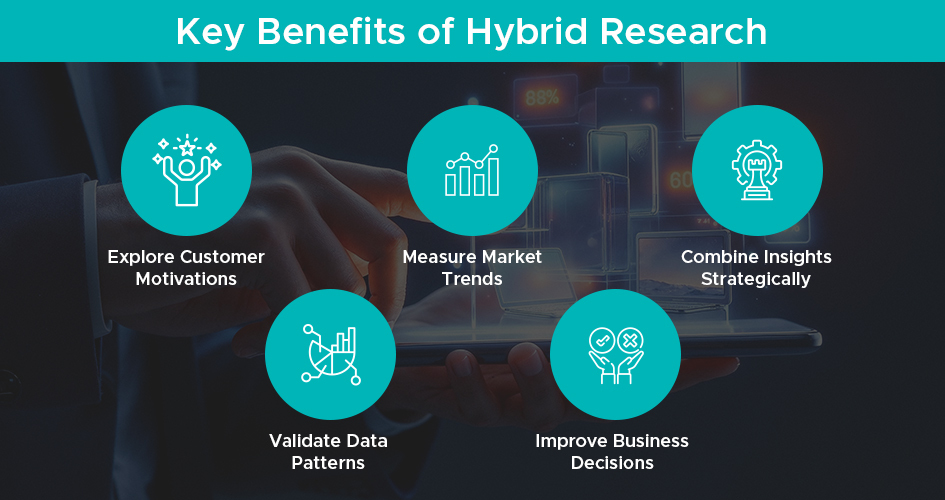
When businesses are looking for informed decisions, either data or narrative on its own can be inadequate. A hybrid research approach; in which quantitative market research and qualitative market research are combined; bridges the gap. Through the intermingling of quantitative, measurable data and deep, contextual knowledge, business organizations obtain a comprehensive knowledge of their marketplace, customer and opportunities.
This article explores how combining qualitative and quantitative research creates a robust framework, its benefits, best practices and how companies can leverage it effectively, particularly through Insights Opinion, a leading online qualitative market research company.
Understanding Qualitative and Quantitative Research
Before diving into hybrid approaches, it’s essential to understand the core differences between qualitative and quantitative research.
Qualitative Research
- Focus: Explores the why and how behind behaviors, attitudes and motivations.
- Methods: In-depth interviews, focus groups, ethnography, online forums.
- Output: Rich, descriptive insights that uncover trends, perceptions and emotions.
Quantitative Research
- Focus: Measures the what, how many and how often.
- Methods: Surveys, structured questionnaires, data analytics, polls.
- Output: Numerical data that can be statistically analyzed, offering measurable insights.
Individually, both approaches provide value. Qualitative research excels in depth but may lack scale while quantitative research provides scale but may miss nuance. This is where a mixed methods research or hybrid approach becomes indispensable.
What is Hybrid Research?
Hybrid research is the strategic integration of both quantitative and qualitative methods within a single, unified research methodology. Where both are considered as a different activity, hybrid research adopts the strengths of both offering depth as well as breadth in examining conditions in the marketplace.
Why Hybrid Research Matters
- Offers a 360-degree view of customers, markets and competitors.
- Minimizes biases that may arise from a single research method.
- Enhances predictive accuracy and improves strategic decision-making.
- Optimizes ROI on research investments by generating actionable insights.
By combining these methodologies, businesses gain clarity that neither approach could achieve alone.
How Qualitative and Quantitative Research Complement Each Other
To appreciate the hybrid model, it’s helpful to see how qualitative and quantitative research intersect.
| Aspect | Qualitative Research | Quantitative Research | Hybrid Benefit |
|---|---|---|---|
| Purpose | Explore perceptions and motivations | Measure patterns and frequency | Understand why and how widespread behaviors occur |
| Data Type | Descriptive | Numerical | Comprehensive, actionable insights |
| Sample Size | Small, focused | Large, representative | Optimized sampling with both depth and scale |
| Outcome | Insights & hypotheses | Statistical validation | Validated insights with context |
| Flexibility | High | Structured | Flexibility with measurable outcomes |
By leveraging this synergy, organizations not only identify patterns but also understand the reasoning behind them.
Steps to Implement a Hybrid Research Approach
Executing hybrid research effectively requires a structured methodology. Here’s a step-by-step guide:
1. Define Research Objectives
Clear objectives help determine which combination of qualitative and quantitative methods will yield the most actionable insights. For example:
- Understanding customer satisfaction trends (quantitative)
- Exploring why certain experiences influence brand loyalty (qualitative)
2. Conduct Qualitative Research First (Exploratory Phase)
Starting with qualitative research helps uncover unknown variables, develop hypotheses and shape survey questions for subsequent quantitative research.
- Methods: Focus groups, interviews, ethnographic studies.
- Outcome: Insightful themes, behavioral drivers and emerging patterns.
3. Design Quantitative Research Based on Qualitative Insights
Use findings from qualitative research to construct structured surveys or experiments.
- Methods: Online questionnaires, polls, structured data collection.
- Outcome: Validation of patterns, statistical significance, trend measurement.
4. Integrate Findings
Combine qualitative narratives with quantitative metrics to produce a cohesive report.
- Present patterns with supporting stories and examples.
- Use visuals like graphs, charts and infographics to communicate insights effectively.
5. Apply Insights Strategically
The ultimate goal of hybrid research is actionable intelligence:
- Optimize marketing campaigns based on validated customer preferences.
- Improve product development through both measured demand and user feedback.
- Inform business strategy with a balance of data-backed decisions and human context.
Challenges in Hybrid Research
While powerful, hybrid research comes with its own set of challenges:
1. Resource Intensiveness
Combining two research methodologies can be costlier and more time-consuming than using one.
2. Data Integration
Synthesizing qualitative narratives with quantitative metrics requires analytical rigor and clear frameworks.
3. Methodological Expertise
Teams must understand both qualitative and quantitative methodologies to avoid misinterpretation of findings.
4. Sample Design Complexity
Aligning small qualitative samples with large quantitative ones requires careful planning to ensure representativeness.
Best Practice: Partner with an experienced online qualitative market research company like Insights Opinion to navigate these challenges efficiently.
Best Practices for Successful Hybrid Research
To maximize value, businesses should consider these proven practices:
- Start with Clear Objectives: Define what decisions the research will support.
- Use Qualitative Research for Hypothesis Generation: Let exploratory insights guide your quantitative study.
- Ensure Sample Representativeness: Large enough for statistical validity, yet focused enough for qualitative depth.
- Leverage Technology: Use advanced survey platforms, analytics dashboards and online focus groups for seamless integration.
- Iterate and Refine: Treat hybrid research as a cyclical process, insights from one phase inform the next.
- Communicate Insights Clearly: Use storytelling for qualitative findings and data visualization for quantitative results.
Examples of Hybrid Research in Action
Seeing hybrid research in action helps illustrate how combining qualitative market research and quantitative data analysis services translates insights into real-world business strategies.
Product Development
- Qualitative: Gather customer opinions on prototype features.
- Quantitative: Survey larger audiences to quantify feature preferences.
- Result: Data-driven design improvements aligned with real user needs.
Brand Perception
- Qualitative: Explore emotional connections with the brand.
- Quantitative: Measure overall brand awareness and perception scores.
- Result: Targeted marketing strategies that resonate emotionally and practically.
Customer Experience
- Qualitative: Conduct in-depth interviews to identify pain points.
- Quantitative: Track satisfaction metrics and Net Promoter Scores (NPS).
- Result: Actionable strategies for improving retention and loyalty.
Tools and Technologies Supporting Hybrid Research
Modern research benefits greatly from technology:
- Survey Platforms: For efficient quantitative data analysis services.
- Online Focus Groups & Forums: For cost-effective qualitative exploration.
- Analytics Tools: Integrate qualitative codes with quantitative metrics.
- Visualization Software: Communicate hybrid insights with clarity to stakeholders.
These tools make executing hybrid research faster, scalable and more precise.
The Value Proposition of Hybrid Research
Hybrid research goes beyond data collection, it drives informed decision-making with actionable insights. Key benefits include:
- Holistic Understanding: Combines emotional and rational perspectives.
- Predictive Accuracy: Validates trends for more reliable forecasting.
- Competitive Advantage: Enables strategic decisions rooted in both context and measurement.
- Efficient Resource Use: Avoids costly trial-and-error by aligning qualitative exploration with quantitative validation.
Companies like Insights Opinion specialize in providing this integrated approach, ensuring organizations receive high-quality, reliable insights that influence real-world business outcomes.
The Future of Combining Qualitative and Quantitative Insights!
Merging quantitative and qualitative research in a hybrid method is now a necessity, not an option, among organizations seeking deep, practical intelligence. The infusing of qualitative and quantitative in a strategically designed method allows companies to uncover latent patterns, validate assumptions and make informed decisions.
From creating richer customer experiences, simplifying products or helping inform marketing campaigns, the mixed methods style of research gives depth insight and reliability that solo-method research cannot. When companies seek to make data meaningful action, hybrid research with established partners such as Insights Opinion gives accuracy and context and clears a path into more astute business decisions.
Frequently Asked Questions:
What is hybrid research?
Ans. Hybrid research combines qualitative and quantitative methods to provide both deep insights and measurable data for better decision-making.
How do qualitative and quantitative research work together?
Ans. Qualitative research explores the why, while quantitative research measures the what. Together, they give a complete view of customer behavior.
What challenges exist in hybrid research?
Ans. Common challenges include data integration, sample alignment, resource needs and methodological expertise.
How does hybrid research benefit businesses?
Ans. It delivers actionable insights, validates trends, improves customer understanding and supports strategic decisions.









